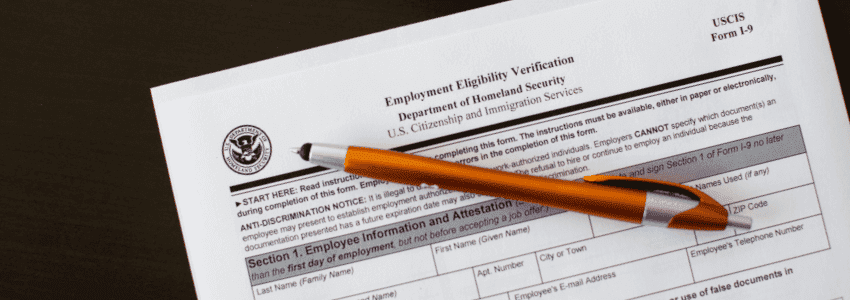How to Conduct an Internal I-9 Audit
Last Updated on October 16, 2024 / HR Compliance, Recordkeeping

HR Question:
I’m doing an internal audit of our I-9 Forms, and I want to make sure I’m doing it right. What are the proper steps to complete the review? And what should I do if I find Form I-9 mistakes?
HR Answer:
Although I-9 audits may seem daunting and cumbersome, they are necessary. Conducting regular audits of your I-9 forms and correcting them appropriately can significantly reduce financial and legal risks. To do this, you’ll want to take the best steps to complete a thorough review and identify any necessary corrections. Leveraging our experience completing countless I-9 audits for our clients, we will share recommendations to help you through an I-9 audit and the correction process if you discover Form I-9 mistakes.
Where do I start?
First, you should identify why you are conducting an audit before you begin. Are there concerns that all of the documents are not in place? Are you just making sure everything is accurate with a plan to do a sample audit? Be sure that you clearly define the scope and that it is non-discriminatory.
When conducting I-9 audits for clients, we find it is best to be proactive in letting employees know about the upcoming audit and address common concerns on the front end. For example, employees can feel concerned when they are asked for I-9 documents. Questions often arise about the timing of the audit (“Why now?”) and general concerns about what happens with the documents they are sharing with you. We have found that being transparent about what you plan to do and explaining the “why” ahead of the audit can help to allay employee concerns.
Can’t I just “start over” instead of conducting an audit?
In some instances, it may seem “easier” to start over and request new forms from every employee. Although it is possible, it is not necessarily recommended because it can lead to additional compliance concerns.
If you choose to complete new forms for every employee, do not throw away the old ones. According to its I-9 audit guidance, the Office of Special Counsel for Immigration-Related Unfair Employment Practices recommends that if you replace a form, you should staple the new form(s) to the old form(s). You should also note in your files the date of the audit and the reason for the review so you can explain why there are multiple forms.
What should I look for during an internal I-9 audit?
As you review your I-9 Forms, it’s important to know what a fully completed form looks like. You should look for the following items in your review:
- Clarity – The information on the form is clear, legible, and easy to read.
- Employee Section (section 1) – This section is completely filled out either prior to the start date (but after an offer of employment has been made) or on the first day of employment. The employee should date and sign section 1.
- Employer Section (section 2) – This section is filled out within 3 days of the employee starting.
- Documents are listed in appropriate sections (Either A only or B and C).
- Date of hire is completed in the Certification section at the bottom of the form and matches the date in the payroll records.
- Signature, date, and address of the company have been completed.
- For hard copy files – Ensure highlighting marks, hole punches, and staples do not interfere with an authorized official’s ability to read the information on the form.
- For electronic files – Be sure to follow proper electronic storage protocol.
- Abbreviations – If used, should be widely understood. Do not use an abbreviation that is not widely known.
- Completeness – All applicable sections of the form are completed.
- Form I-9 Version – The current version of Form I-9 should be used. To determine whether you are using the correct version of Form I-9, look at the revision date printed on the bottom left corner of the form, and not the expiration date printed at the top of the form. For your convenience, here is a link to the current version of the Form I-9.
- Language – The English version of the form should be completed unless the form is being completed in Puerto Rico. The Spanish version is approved for use only in Puerto Rico.
How do I correct Form I-9s?
If you come across Form I-9 mistakes, the United States Citizenship and Immigration Services (USCIS) provides recommendations for making corrections. To learn more, see our article about how to handle missing or incorrect I-9 forms.
Additional audit resources
Rest assured, there are several resources available to help you complete the Form I-9 correctly and conduct an internal audit. The U.S. Immigration Customs and Enforcement and the Office of Special Counsel for Immigration-Related Unfair Employment Practices have provided joint guidance to help employers perform internal audits. The USCIS also has an “I-9 Central” section where you can find in-depth information on how to complete the form, make corrections, review descriptions of acceptable documents, and much more. And should you have additional questions, you can always contact your legal counsel.
By conducting internal audits and taking appropriate actions if mistakes are found, you can feel confident that you are pursing the right steps to support your compliance.
Thank you to Patti Dunham, MBA, MA, SPHR, SHRM-SCP, Director of Business Strategy & Quality for sharing her expertise on I-9 audits.
Employment recordkeeping doesn’t rank high on the list of favorite HR responsibilities, but it is vitally important. Take the I-9 Form for example. Failure to complete this form properly can result in costly fines. Clark Schaefer Strategic HR can assist with all of your recordkeeping compliance needs, including conducting I-9 audits. Visit our HR Compliance & Recordkeeping Services to learn more, or Contact Us today.



